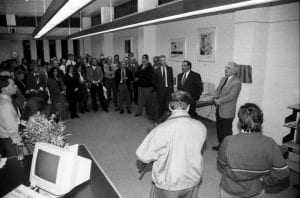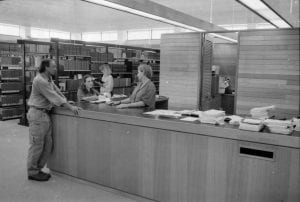Written by Caitlin Picker
The law library has been a learning space for law students for the past 25 years. It was established in 1993 and officially opened in 1994. During the first few years funding for the law library was limited, and the School of Law wanted the library to stock rare law books. The law library was seen as a necessary tool for students completing a law degree.
In an application for funding for the law library it was written it was ‘… necessary to pay particular attention to the necessity to fund a law library as a part of the commitment which the University has undertaken to those students whom it has enrolled in LLB and LLB (graduate) degrees.
The law library was essential to the work of teaching and researching law. It was, and still is imperative that the staff and students have ready access to the materials of the law. It was argued that without the law library, staff and students would not be able to undertake their work. The law libraries and the materials were more uniquely important to the discipline of law in tertiary education than to any other discipline.
When the library first opened, it had 86 places for students to study. This meant the library could cater to 50% of internal students and 35% of external students if necessary. The law library was equipped with tables, chairs, shelving and computers. The law librarian and library staff had computer equipment. There was a bank of 13 computers available for users in the library. Two of these computers were dedicated to accessing the library catalogue, seven gave access to the CD Rom collection and four were used to access the internet. Learning and Teaching Services Librarian, Annette Messell reveals older legal practitioners and law lecturers will remember loose-leaf services and learning how to file pages of updates in binders, but the majority of these sources can now be found and updated online at the law library site.
The law library was seen as a place where law students would learn how to conduct legal research using primary legal materials. This was an important skill, as outlined in a funding application which read, ‘if they cannot conduct independent research when they graduate, they have not satisfied a major learning objective of university law students’. Learning & Teaching Services Librarian, Annette Messell says, “Students don’t often realise that big law firms have their own libraries and librarians working for them to assist with research”. But she believes the sooner students start to develop their own legal research skills and familiarity with legal resources both in print and online, the better it will be for their career in the long-run.
The law library continues to be used by the academic staff and students in the School of Law and by the wider academic community at the University of New England. It is also frequented by members of the legal profession and by other members of the local community.
Today the law library is shared with the UNE Business School. The resources available at the law library range from print materials like textbooks, to primary case law and legislation. However, a law library is so much more than a physical space. Annette explains 25 years ago the law library was a space where all resources could be located in books, but today they are now available online. Students will be familiar with the law library page on the UNE Library website, which lists all the UNE Library online legal resources.
Annette Messell expresses, “The future has always been now for law libraries and libraries in general.” No longer are librarians gatekeepers of knowledge, but guides for the uninitiated to navigate the wealth of information that exists in the online space. The thought of a book sitting on a shelf waiting to be read is both reverent and romantic… but it’s not the future”. Annette believes over the next 25 years libraries will continue to change and grow online in the face of “fake news” and information overload.







Books will always be there.there is nothing that can replace the romanticism of a,book.print binding of books its covers .oh so so nice.books,have a special aura to them that can never never be replaced by online materials.technically books have serependity while online materials don’t.information retrieved from books falls into place eventually.oh I love books can’t live without them.